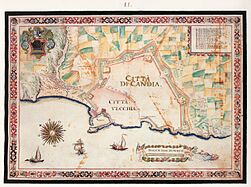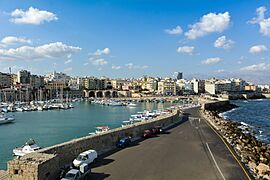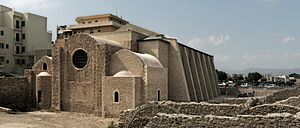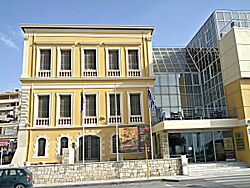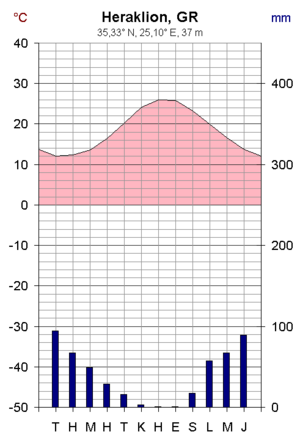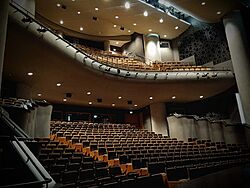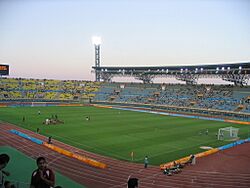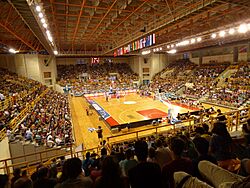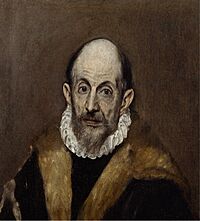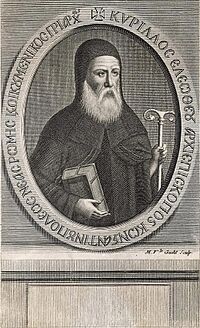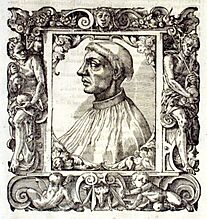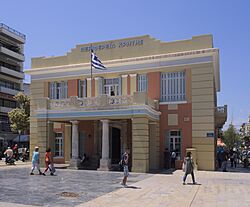Heraklion facts for kids
Quick facts for kids
Heraklion
Ηράκλειο
|
||
|---|---|---|
 Clockwise from top: Panoramic view of the city of Heraklion and the Sea of Crete, Agios Minas Cathedral, Night view of the Harbor of Heraklion, and Venetian fortress of Koules/Castello.
|
||
|
||
| Country | Greece | |
| Administrative region | Crete | |
| Regional unit | Heraklion | |
| Area | ||
| • Municipality | 244.6 km2 (94.4 sq mi) | |
| • Municipal unit | 109.0 km2 (42.1 sq mi) | |
| Highest elevation | 33 m (108 ft) | |
| Lowest elevation | 0 m (0 ft) | |
| Population
(2021)
|
||
| • Urban | 211,370 | |
| • Municipality | 179,302 | |
| • Municipality density | 733.04/km2 (1,898.6/sq mi) | |
| • Municipal unit | 156,842 | |
| • Municipal unit density | 1,438.9/km2 (3,726.8/sq mi) | |
| Demonym(s) | Heraklian, Heraclian | |
| Time zone | UTC+2 (EET) | |
| • Summer (DST) | UTC+3 (EEST) | |
| Postal code |
70x xx, 71x xx, 720 xx
|
|
| Area code(s) | 281 | |
| Vehicle registration | HK, HP, HZ | |
| Website | Heraklion-city.gr | |
Heraklion is the biggest city and the main capital of the island of Crete. It is also the capital of the Heraklion region. This city is the fourth largest in Greece. About 179,302 people live in the city itself (2021 numbers). If you include the wider area, the population is around 211,370.
People have lived in the Heraklion area for a very long time. It has been continuously inhabited since at least 7000 BCE. This makes it one of the oldest places where people have lived in Europe. Heraklion is also home to the ancient Knossos Palace. This palace was a major center for the Minoan civilization from about 2000-1350 BCE. Many people think Knossos is Europe's oldest city. It is one of the most important old sites in Greece. Only the Parthenon gets more visitors.
Heraklion became Europe's fastest-growing tourist spot in 2017. It saw an 11.2% increase in international visitors. In 2017, Heraklion was the 20th most visited region in Europe. It was the 66th most visited place on Earth. It was also the 2nd most visited place in Greece. About 3.2 million people visited in 2017. In 2018, 3.4 million people visited, making it the 19th in Europe.
Contents
- What's in a Name? The Story of Heraklion's Names
- A Journey Through Heraklion's History
- Exploring Heraklion's Buildings and Art
- How Heraklion is Organized
- Getting Around Heraklion: Transportation
- Heraklion's Weather and Climate
- Learning and Research in Heraklion
- Culture and Fun in Heraklion
- Famous People from Heraklion
- Heraklion's Global Connections
- Where is Heraklion?
- Images for kids
- See also
What's in a Name? The Story of Heraklion's Names
The name Heraklion (Ηράκλειον) was brought back in the 1800s. Locals started using it around 1867. It comes from an ancient city and port called Herakleion. This old port was named after the famous hero Heracles (Hercules). In ancient times, Herakleion was the port for Knossos. Knossos was about 3.7 kilometers away. The ancient port was located near where Heraklion's modern port is today.
Other Names for Heraklion Through Time
Heraklion has had many names over the centuries. Each name tells a bit about its history.
- Ancient Times: The area that is now Heraklion was the port for the ancient city of Knossos. Knossos was a big center of the Minoan civilization. This port helped with trade and communication across the Mediterranean Sea. As Knossos became less important, the port grew. It eventually became a major city.
- Rabḍ al-ḫandaq: In 824 CE, Arab people from al-Andalus (Spain) took over Crete. They made a new capital city. They called it rabḍ al-ḫandaq, which means "Castle of the Moat."
- Chándax / Chándakas: The Arabic name rabḍ al-ḫandaq was changed into Greek. It became Χάνδαξ (Chándax) or Χάνδακας (Chándakas).
- Candia: This name came from Chándax. It was used in many European languages, like Italian, Latin, Spanish, French, and English. Sometimes, "Candia" referred to the whole island of Crete. The Ottoman name for the city was Kandiye.
- Megalo Kastro: After the Byzantine Empire took Crete back, the city was known as Megalo Kastro. This means 'Big Castle' in Greek. The people who lived there were called Kastrinoi, meaning "castle-dwellers."
A Journey Through Heraklion's History
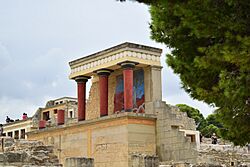
Heraklion has a very long and interesting history. It goes back thousands of years.
The Minoan Era: Europe's Oldest City
Heraklion is home to the ancient Knossos Palace. This palace is on the southern edge of the city. Many people believe Knossos was the biggest city on Crete during the Minoan times. It is often called the oldest city in Europe. Knossos had a port in the Heraklion area. This port was used from the very beginning of the Early Minoan period (3500 to 2100 BC).
Ancient Times: After the Minoans
After the Minoan civilization ended, Heraklion and the rest of Crete did not grow much. There was little new building in the area. When the Romans arrived, some construction began. However, in early Byzantine times, the area was known for pirates and bandits.
The Emirate of Crete: A New Capital
In 824, Heraklion was chosen as the capital. Fortifications started being built the next year. This was done by Arabs who had been forced out of Al-Andalus (Spain). They took over the island from the Eastern Roman Empire. They built a moat around the city for protection. They named it rabḍ al-ḫandaq ("Castle of the Moat"). This name was later changed to Χάνδαξ (Chandax) in Greek. The city became the capital of the Emirate of Crete (about 827–961). The Saracens used the port as a safe place for pirates. These pirates attacked Byzantine ships and raided Byzantine lands.
Byzantine Era: Return to Greek Rule
In 960, Byzantine forces arrived in Crete. They were led by Nikephoros Phokas, who later became Emperor. They attacked the city. After a long siege, the city fell in March 961. The Arab people living there were killed. The city was looted and burned down. It was soon rebuilt. The town stayed under Byzantine control for the next 243 years.
Venetian Era: Strong Walls and New Life
In 1204, the Republic of Venice bought the city. The Venetians made the city's defenses much stronger. They built huge fortifications, which you can still see today. These included a massive wall, up to 40 meters thick in some places. It had seven bastions and a fortress in the harbor. Chandax was renamed Candia. It became the main city of the Duke of Candia. The Venetian area of Crete was called "Regno di Candia" (Kingdom of Candia). The city kept the name Candia for centuries. This name was often used for the whole island of Crete. To make their rule stronger, the Venetians brought families from Venice to live in Crete starting in 1212. The mix of two cultures and the ideas of the Italian Renaissance led to a boom in arts and learning in Candia and Crete. This period is known as the Cretan Renaissance.
Ottoman Era: A Long Siege
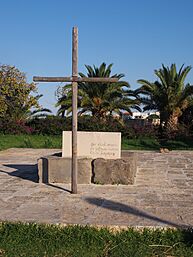
During the Cretan War (1645–1669), the Ottomans attacked the city. They besieged it for 21 years, from 1648 to 1669. This was the longest siege in history at that time. In the final part of the siege, which lasted 22 months, many people died. This included 70,000 Turks, 38,000 Cretans and slaves, and 29,088 Christian defenders. The Ottoman army, led by Köprülü Fazıl Ahmed Pasha, took the city in 1669.
Under the Ottomans, Kandiye was the capital of Crete until 1849. Then Chania became the capital. In Greek, people often called it Megalo Castro ('Big Castle'). During the Ottoman period, the harbour filled with sand. So, most shipping moved to Chania on the west side of the island.
Modern Era: New Beginnings
An earthquake hit off the coast of Crete on October 12, 1856. It destroyed most of the 3,600 homes in the city. Only 18 homes were left standing. The disaster killed 538 people in Heraklion.
In 1898, the Cretan State was created. It was a self-governing state under Ottoman rule. Prince George of Greece was in charge. During this time, the city was renamed "Heraklion." This name came from the ancient Roman port of Heracleum. In 1913, Heraklion became part of the Kingdom of Greece, along with the rest of Crete. Heraklion became the capital of Crete again in 1971, taking over from Chania.
Exploring Heraklion's Buildings and Art
Heraklion has many interesting buildings, statues, and old walls. They show its long history.
The oldest building is the palace in Knossos. It is just outside the city.
Two large medieval churches were the Dominican church of St. Peter (built 1248-1253) and San Salvatore. San Salvatore was torn down in 1970.
Other old buildings from the Venetian times include the Saint Mark's Basilica. There is also the Renaissance loggia near Lions Square (built 1626–28).
Around the old city center, you can see many defensive walls, bastions, and other fortifications. These were first built in the Middle Ages. The Republic of Venice completely rebuilt them. These strong walls helped the city survive the longest siege in history for 21 years. The city finally fell to the Ottomans in 1669. The Koules Fortress (Castello a Mare), the ramparts, and the arsenal are important parts of the port area.
Many fountains from the Venetian era are still here. These include the Bembo fountain, the Priuli fountain, and the Morosini fountain in Lions Square (1628).
Buildings from the 1800s include the St Titus Cathedral, built in 1869. It was first a mosque. The Agios Minas Cathedral (1862–95) is another example.
A modern building is the Heraklion Archaeological Museum. It was built between 1937 and 1940.
You can find many sculptures and statues around the city. They honor important people and events. Some of these include El Greco, Vitsentzos Kornaros, Nikos Kazantzakis, and Eleftherios Venizelos.
How Heraklion is Organized
The city of Heraklion is part of a larger area called the Municipality of Heraklion. This municipality was formed in 2011. It joined five smaller areas together. These areas are:
- Gorgolainis
- Heraklion (the main city)
- Nea Alikarnassos
- Paliani
- Temenos
The whole municipality covers about 244.6 square kilometers. The main city area covers about 109.0 square kilometers.
Neighborhoods of Heraklion
Heraklion has many different neighborhoods where people live. Some of them are:
- Agia Ekaterini
- Agia Erini Chrisovalantou
- Agia Marina
- Agia Triada
- Agios Dimitrios
- Agios Ioannis Chostos
- Agios Minas
- Agios Titos
- Akadimia
- Ampelokipoi
- Analipsi
- Atsalenio
- Chanioporta
- Chrisopigi
- Dilina
- Dimokratias
- Estavromenos
- Filothei
- Fortetsa
- Ilioupoli
- Kamaraki
- Kaminia
- Katsampas
- Kenouria Porta
- Kipoupoli
- Komeno Mpenteni
- Korakovouni
- Koroni Magara
- Knossos
- Lido
- Marathitis
- Mastabas
- Mesabelies
- Mpentevi
- Nea Alatsata
- Pananio
- Papatitou Metochi
- Pateles
- Poros
- Therissos
- Tris Vagies
- Xiropotamos
Suburbs and Nearby Villages
Heraklion also has several suburbs and smaller villages close by. These include:
- Agia Erini
- Agia Marina
- Agioi Theodoroi
- Agios Syllas
- Ammoudara
- Amnisos
- Ano Kalesia
- Athanati
- Dafnes
- Finikia
- Gazi urban area
- Giofyrakia
- Gournes Temenous
- Kallithea
- Karteros
- Kato Kalesia
- Kavrochori
- Kollyvas
- Ksirokabos
- Malades
- Nea Alikarnassos urban area
- Sillamos
- Skafidaras
- Skalani
- Vasilies
- Voutes
- Psari Forada
Getting Around Heraklion: Transportation
Heraklion is a major hub for travel. It has a busy port and a big airport.
The Port: Gateway to the Islands
Heraklion has an important port for shipping and ferries. From here, you can take ferries to many Greek islands. These include Santorini, Ios Island, Paros, Mykonos, and Rhodes. There are also direct ferries to Naxos, Karpathos, Kasos, Sitia, Anafi, Chalki, and Diafani. Many ferries also go daily to Piraeus, which is the port of Athens in mainland Greece. The port of Heraklion was finished in 1928.
The Airport: Nikos Kazantzakis Airport
Heraklion International Airport is also known as Nikos Kazantzakis Airport. It is about 5 kilometers east of the city. The airport is named after Nikos Kazantzakis, a famous writer and philosopher from Heraklion. It is the second busiest airport in Greece. It is the busiest for charter flights. In 2022, over 8 million passengers used it. This is because Crete is a very popular holiday spot.
Roads and Buses
The European route E75 highway goes through Heraklion. It connects the city to other major cities on Crete. These include Agios Nikolaos, Chania, and Rethymno.
City buses serve Heraklion. They have 39 different routes to help people get around. Buses also connect Heraklion to many other big places on Crete.
Railway History
From 1922 to 1937, a special industrial railway was used. It connected the Koules fortress to Xiropotamos. This railway helped with building the harbor. There are no current plans for a passenger railway system on Crete.
Heraklion's Weather and Climate
Heraklion has a hot-summer Mediterranean climate. This means it has warm to hot and dry summers with clear skies. Dry, hot days often feel better because of cool breezes from the sea. Winters are mild with some rain. Heraklion is further south than Athens, so its winters are warmer. But its summers are cooler than Athens because of the Aegean Sea. The highest temperature in summer is usually around 28-30°C. Snow is very rare in Heraklion. The last time there was a lot of snow was in February 2004.
Learning and Research in Heraklion
Heraklion is a center for education and research. It has several important institutions:
- University of Crete
- Hellenic Mediterranean University (HMU)
- MBS College
- Foundation for Research & Technology - Hellas (a big research center)
- Nicolas Kitsikis Library
- Vikelaia Library
- 3rd High School of Heraklion
- 5th High School of Heraklion
Culture and Fun in Heraklion
Heraklion has a rich culture with many museums, arts, and sports.
Museums to Explore
- Heraklion Archaeological Museum: This museum has amazing artifacts from the Minoan civilization.
- Cretaquarium: An aquarium where you can see sea creatures from the Mediterranean.
- Historical Museum of Crete: Learn about Crete's history from early Christian times to today.
- Natural History Museum: Discover the plants and animals of Crete and the wider Mediterranean.
- The Battle of Crete and National Resistance Museum: Learn about a major battle during World War II.
- Nikos Kazantzakis Museum: Dedicated to the famous writer Nikos Kazantzakis.
- Collection of Agia Aikaterini of Sinai: A collection of religious art.
- Museum of Visual Arts
Arts and Performances
The Cultural and Conference Center of Heraklion is a modern place for shows and events. You can see plays, concerts, and other performances there.
Sports in the City
Heraklion has several sports clubs. The most famous are OFI and Ergotelis. These are football (soccer) clubs that have played in Greece's top league. The city is also home to the Heraklion Football Clubs Association. This group manages football for the whole region. Other notable sports clubs include Iraklio B.C. (basketball), Atsalenios (football), and Irodotos (football).
Local TV Stations
Heraklion has its own local TV channels:
- Channel 4
- Creta Channel
- Kriti TV
- MyTV
Famous People from Heraklion
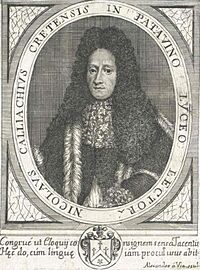

Heraklion has been the hometown of many important Greek people. These include:
- Writers:
- Nikos Kazantzakis (1883–1957): A famous novelist, best known for Zorba the Greek.
- Odysseas Elytis (1911–1996): A poet who won the Nobel Prize.
- Elli Alexiou (1894–1988)
- Rea Galanaki (born 1947)
- Lili Zografou (1922–1998)
- Scientists and Thinkers:
- Nicholas Kalliakis (1645–1707): A Greek scholar and philosopher.
- Francesco Barozzi (1537–1604): A mathematician and astronomer.
- Joseph Sifakis (1946–present): A computer scientist who won the Turing Award.
- Marcus Musurus (1470–1517): A scholar and philosopher.
- Painters and Sculptors:
- El Greco (1541–1614): A world-famous painter, sculptor, and architect.
- Michael Damaskinos (1530/35–1592/93): A painter of icons.
- Yiannis Parmakelis (born 1932): A sculptor.
- Music:
- Giannis Markopoulos (born 1939): A composer.
- Notis Sfakianakis (born 1959): A singer.
- Sports:
- Nikos Machlas (born 1973): A footballer.
- Georgios Samaras (born 1985): A footballer.
- Giorgos Giakoumakis (born 1994): A footballer.
- Other Notable People:
- Rika Diallina (born 1934): An actress and model.
- Gianna Angelopoulos-Daskalaki (born 1955): A businesswoman and lawyer.
- Kyrillos Loukaris (1572–1637): A theologian and Patriarch.
Heraklion's Global Connections
Heraklion has connections with many cities around the world.
Consulates in Heraklion
Several countries have consulates in Heraklion. A consulate is like a small office that helps citizens of that country who are traveling or living abroad.
 Austria
Austria Belgium
Belgium Czech Republic
Czech Republic Denmark
Denmark Finland
Finland France
France Germany
Germany Hungary
Hungary Republic of Ireland
Republic of Ireland Italy
Italy Netherlands
Netherlands Norway
Norway Philippines
Philippines Poland
Poland South Korea
South Korea United Kingdom
United Kingdom
Twin Towns and Sister Cities
Heraklion is "twinned" with other cities around the world. This means they have special friendly relationships and often share culture or ideas.
 Limassol, Cyprus
Limassol, Cyprus Constanța, Romania (1992)
Constanța, Romania (1992) Odesa, Ukraine (1992)
Odesa, Ukraine (1992) Toledo, Spain (2017)
Toledo, Spain (2017) Nizhny Novgorod, Russia (2018)
Nizhny Novgorod, Russia (2018) Tampa, United States (2019)
Tampa, United States (2019) Čukarica, Serbia (2019)
Čukarica, Serbia (2019) Ningbo, China (2019)
Ningbo, China (2019)
Where is Heraklion?
Heraklion is located on the island of Crete. It is in the middle of the northern coast.
| Fira | ||
| Chania – Rethymno | 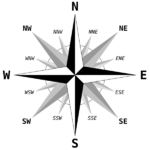 |
Agios Nikolaos |
| Tympaki – Moires | Archanes | Ierapetra |
Images for kids
-
Knossos Palace
-
Morosini fountain in Lions Square
-
The Phaistos Disk (2nd millennium BC) in Heraklion Archaeological Museum
-
Depiction of the Siege of Candia
See also
 In Spanish: Heraclión para niños
In Spanish: Heraclión para niños




